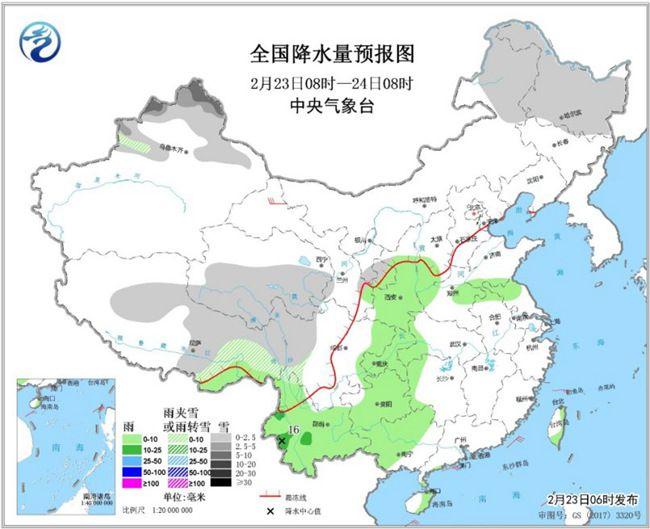China Weather Network News Today and tomorrow (23-24), affected by low-level shear lines, there will be a precipitation process in North China, Huanghuai, Jianghan and other places, mainly small to moderate rain, Shandong, Jiangsu and Anhui Areas may experience heavy rain. In terms of temperature, in the next two days, the temperature in Jiangnan and other places will continue to rise, and the 20 ° C range will continue to expand, which is expected to enter the spring in the meteorological sense in advance.
Yesterday, the snowfall in the Northeast began to decrease significantly. Only the eastern region remained relatively strong, such as light to moderate snow in eastern and southern Heilongjiang, central and eastern Jilin, eastern Tibet, and southern Qinghai, and heavy snow in Naqu, Tibet. However, except for the precipitation in the northeast, the weather in most parts of northern China is relatively sunny, such as Beijing. Yesterday the sky was blue and the temperature rose, welcoming a sunny day.
The weather in Beijing was fine yesterday, and the blue sky and the lake contrasted. (Picture / Wang Xiao)
Today and tomorrow, affected by low-level shear lines, rainfall in North China, Huanghuai, and Jianghan will gradually increase, mainly from light to moderate rain, with heavy rain in some areas. Specifically, according to the forecast of the Central Meteorological Station, today there are light to moderate snow or sleet in parts of northern Xinjiang, northeastern Inner Mongolia, eastern northeast China, northern Tibet and eastern China, and southern Qinghai. Among them, some areas in northern Xinjiang There is heavy snow. There was light rain in the east and southwest of the southwest, western Guangxi, and the southeast of the northwest, and there was moderate rain in western Yunnan.
Tomorrow there will be light snow or sleet in parts of northern Xinjiang, eastern Inner Mongolia, southern Qinghai, and central and eastern Tibet. There was light rain in parts of eastern and central and southern China, Huanghuai, most of Jianghan, eastern southwestern China, central and western Yunnan, and most of southern China, and moderate rain in parts of southern Huanghuai. In areas of western Inner Mongolia and other places, there are 4 to 5 winds.
In addition, looking ahead to the 26th and 29th, there will be a significant precipitation process from north to south in the northwest, south of North China, Huanghuai, Jianghan, Jianghuai, Jiangnan, west and north of China, but the time is far away. What will happen? The appearance of the precipitation phase is still not good enough. The local public needs to pay attention to the near-term forecast and take measures to prevent rain (snow) weather.
Turning to the temperature again, the temperature of Jiangnan and other places will continue to rise in the next two days, and the range of 20 ° C will continue to expand. Especially on the 24th to 25th, the temperature in the Yangtze River Basin will reach a recent high, and the maximum temperature in many places may rise to 25 ° C. Around the beginning of next week, it will be warm as if entering April or early May early. Not only in the Jiangnan region, Jianghuai and east-southwestern regions will also be warmer by about 10 ° C. During this round of temperature rise, the maximum temperature of 20 ° C will be quickly pushed north to the southern Huanghuai and other places. In large cities, the highest temperatures on the 24th in Wuhan and Hefei It can reach up to 24 ° C, Changsha and Nanchang will reach 26 ° C and 25 ° C on the 24th, the highest temperature in Hangzhou on the 25th will reach 26 ° C, and the 25th in Chengdu on the 25th will reach new highs this year.
The continuous warming process may also bring a "surprise" to places such as Jiangnan, that is, this year may enter the spring in the meteorological sense in advance. From the average annual situation, most of the places in the southwest and the south of the Yangtze River do not officially enter the spring until March: Nanchang on March 6, Chengdu on March 7, Wuhan on March 11, Changsha on March 12, Guiyang March 12th, Hangzhou March 13th, Hefei March 19th, Nanjing March 27th, and Shanghai March 27th. However, according to current temperature estimates, the above areas may start to enter the spring in the end of February. Progress.
However, according to the forecast, at the end of February, the temperature in the south may still encounter a "suppression" of cold air. When the weather is warm and cold, the local public is reminded to pay attention to the near-term forecast, add and remove clothing in time, and beware of colds.

